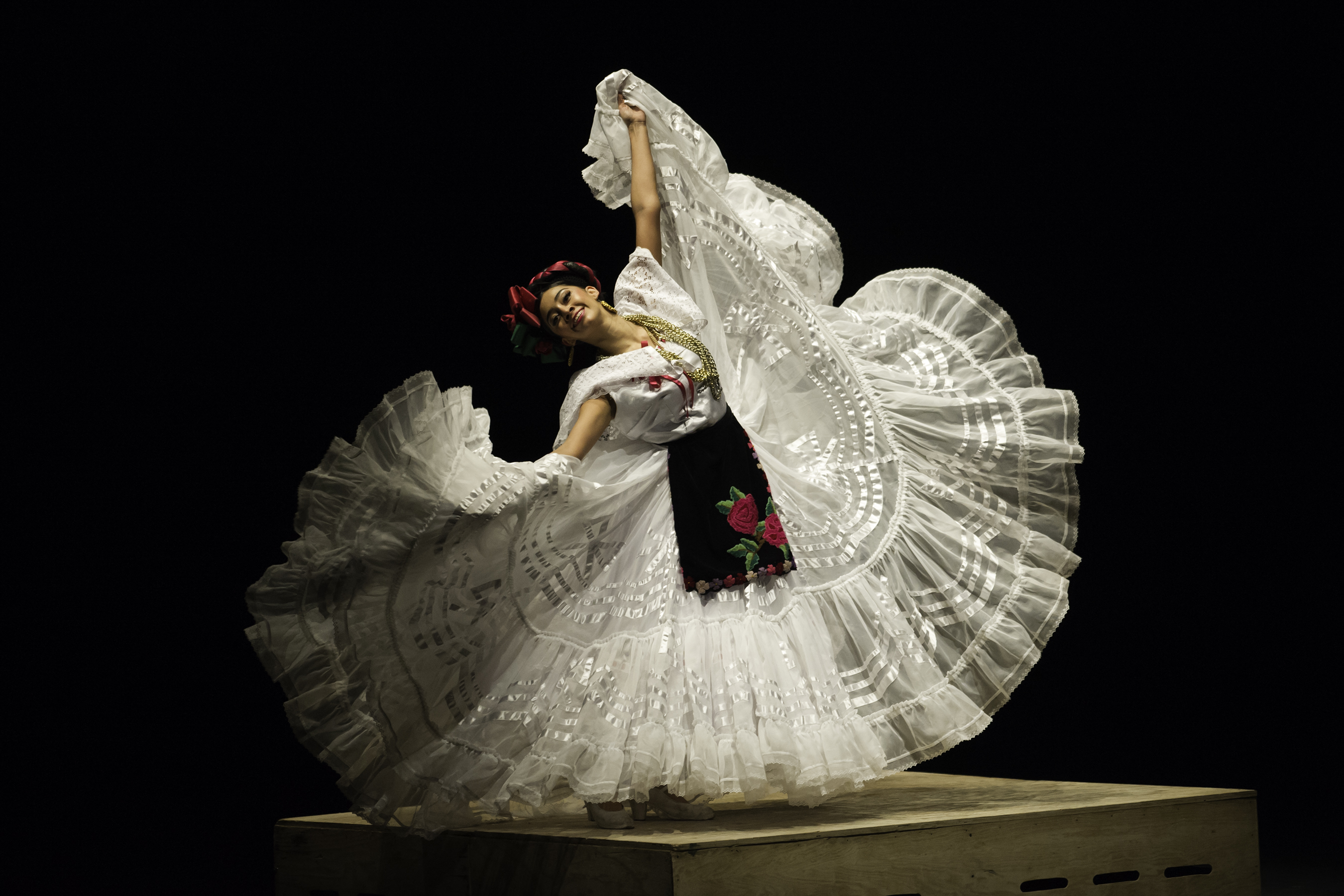
The Auditorium Theatre presents Ballet Folklórico de México de Amalia Hernández, celebrating their 70th anniversary. One of the most famous and celebrated companies in the world, this Auditorium Theatre Visiting Resident Company brings the culture, music, dance, and costumes of Mexico to Chicago on February 12 and 13. The company will also perform a one-hour student matinee on Monday, February 14 for grades K-12.
Ballet Folklórico de México de Amalia Hernández
February 12 @ 7:30PM and February 13 @ 3PM
One-hour student matinee on February 14 @ 11AM
“We are honored to once again bring Ballet Folklórico de México de Amalia Hernández back to Chicago," said Auditorium Theatre CEO Rich Regan. “Not only are these performances cherished by the city's Mexican community, they are also a must-see for any dance fan."
With “whirling, kaleidoscopic splendor” (Boston Globe), the company journeys from the ancient Aztec era to modern day through dances inspired by rituals, revolutions, and festivals. Featuring the renowned choreography of company founder Amalia Hernández, who “brought a brilliant visual and theatrical sense to her dances” (The New York Times) and live music provided by the Ballet Folklórico de México ensemble.
En Español:
Celebrando su 70 aniversario, una de las compañías más afamadas e ilustres del mundo trae la cultura, música, danzas y vestidos de México a Chicago. La compañía residente del Auditorium Theatre traza el trayecto de la cultura ancestral Azteca desde su raíz hasta la actualidad a través de danzas inspiradas en rituales, revoluciones y festivales con un ‘esplendor kaleidoscópico’ (Boston Globe). La compañía presenta las coreografías originales de Amalia Hernández, fundadora, quien ‘brindó un tinte visual y teatral deslumbrante’ (The New York Times) a sus bailes, aunadas a música en vivo tocada por el ensamble del Ballet Folklórico de México.
About Ballet Folklórico de México and Founder Amalia Hernández
Amalia Hernández was a dancer and choreographer, founder of the Ballet Folklórico de México in 1952. From a very young age, she began a long journey through Mexican culture that would lead her to rescue the traditional dances around Mexico. She managed to project to the world the beauty of our country through movement, from pre-Columbian cultures and Spanish influences to the revolutionary times.
With her first performances in 1952, she obtained public recognition as a cultural representative of Mexico. Her great success established the Ballet in the Palace of Fine Arts as its permanent venue since October 11, 1959.
With more than 30 million spectators and countless recognitions, Amalia Hernández's artistic legacy remains valid thanks to the more than 120 original choreographies with great technical difficulty, elaborate typical costumes, and first-rate artists, consolidating the Ballet as the best dance company in the world in its genre.Amalia Hernández was a dancer and choreographer, founder of the Ballet Folklórico de México in 1952. From a very young age, she began a long journey through Mexican culture that would lead her to rescue the traditional dances around Mexico. She managed to project to the world the beauty of our country through movement, from pre-Columbian cultures and Spanish influences to the revolutionary times.
Amalia Hernández fue una bailarina y coreógrafa, fundadora en 1952 del Ballet Folklórico de México. Desde muy joven inició un largo trayecto por la cultura mexicana que la llevaría a rescatar las danzas tradicionales de los diversos rincones de México. Ella logró proyectar ante el mundo la belleza de las diferentes regiones de nuestro país a través del movimiento, desde las culturas precolombinas, las influencias españolas en la época del virreinato hasta la fuerza popular de los tiempos revolucionarios.
Con sus primeras presentaciones en 1952 obtuvo el reconocimiento del público como representante cultural de México. Su gran éxito logró establecer al Ballet en el Palacio de Bellas Artes como su sede permanente a partir del 11 de octubre de 1959.
Con más de 30 millones de espectadores e innumerables reconocimientos, el legado artístico de Amalia Hernández permanece vigente gracias a las más de 120 coreografías originales y con gran rigor técnico, elaborados trajes típicos y artistas de primer nivel, consolidándose como la mejor compañía del mundo en su género.
The 2021-22 Season Dance Sponsor is The Florian Fund
The 2021-22 Student Matinee Sponsors are The Robert Thomas Bobins Foundation and Denise Littlefield Sob
PROGRAM/PROGRAMA
(Subject to Change)
Aztecas (Hijos del sol)
Amalia Hernández took diverse elements from the conquerors' chronicles, sculptures, ceramics, and codices to reconstruct these Aztec ritual dances. This ballet is divided into four dances, the Dance of the Priests, in honor of Moctezuma II, the Dance of the Maidens, the Dance of War, and the Dance of Celebration.
Para esta reconstrucción de danzas rituales aztecas, Amalia Hernández tomó elementos de las crónicas de los conquistadores, los relatos, la escultura y la cerámica, así como de los códices. Este ballet se compone de la danza fúnebre del rey Ahuizótl, viene enseguida la Danza de los Sacerdotes, en honor a Moctezuma II, continúa la Danza de las Doncellas, después la Danza de la Guerra y finaliza con la Danza de la Celebración.
Sones Antiguos de Michoacán
This piece is a brilliant mosaic of dances and songs from Michoacán, and one of the most important choreographies of Amalia Hernández, since it changed the course of her career, as well as Mexican dance. Sones Antiguos de Michoacán combines the techniques of modern and classical dance. The choreography is considered by its creator as the first work inspired developed theatrically and remains not only in the repertoire of the Ballet Folklórico de México but also as an inspiration for other Mexican folk dance companies.
Esta pieza es un brillante mosaico de bailes y canciones de Michoacán, y una de las coreografías más importantes de Amalia Hernández, pues cambió el rumbo de su carrera, así como el de la danza mexicana. Sones Antiguos de Michoacán combina las técnicas de la danza moderna y clásica para adaptarlas a la danza folclórica; es una evocación del movimiento capturado en el contexto etnográfico. La coreografía es considerada por su creadora como la primera obra inspirada en el folclor, desarrollada de una forma teatral y continúa vigente no solo en el repertorio del Ballet Folklórico de México, sino también como inspiración para otras compañías y agrupaciones de danza folclórica mexicana.
Tarima de Tixtla
Based on the original dances of Guerrero, Tarima de Tixtla is one of the most colorful and cheerful choreographies in the Ballet Folklórico de México’s repertoire The echo of the tapping shoes shakes the wooden stand, representing with joy the warmth of the people from Guerrero. The swirl of the skirts and the tapping of the dancers’ feet show an incessant dialogue through dance.
Basado en las danzas originarias del estado de Guerrero, Tarima de Tixtla es una de las coreografías más coloridas y alegres en el repertorio del Ballet Folklórico de México. Aquí retumba el eco del zapateado en latarima, enfatizando así, con el ritmo vertiginoso de la alegría, el calor de las almas guerrerenses y la picardía que se sugiere en los movimientos de las bailarinas; ese ajetreo de las faldas y el diálogo que se establece a través de la punta y el talón de los intérpretes.
La Revolución
This ballet is dedicated to the "soldaderas", also called Adelitas, women who had a decisive role in the Mexican Revolution, as they took their lives and few belongings to the war scenes. In quick contrast, the aristocrats are seen in a joyous celebration, when a group of rebels breaks into the party, prepared to fight and march towards their destiny: the Revolution.
Este ballet está dedicado a las soldaderas o Adelitas, mujeres que tuvieron un papel determinante en la Revolución Mexicana, pues trasladaron su vida y pocas pertenencias a los escenarios bélicos. En rápido contraste se ve a los aristócratas en una alegre celebración, cuando un grupo de rebeldes irrumpe en la fiesta, levantándose en armas para marchar hacia su irremediable destino: la Revolución.
La Charreada
One of the most deeply rooted traditions in Mexico is the Charreria, which arises from the equestrian and livestock activities of the different communities of the country. Declared Intangible Heritage of Humanity by UNESCO, Charrería is an art and discipline in which both men and women compete, wearing colorful Mexican costumes trimmed in silver studs. To maintain its popularity, associations were created and also the “Charreadas”, which can be considered as a Mexican rodeo, as well as a highly recognized sport with strict rules and lots of competitions that shows the skills of the “charros” and horsemen.
Una de las tradiciones más arraigadas de México es la Charrería, que surge de las actividades ecuestres y ganaderas de las distintas comunidades del país. Declarada Patrimonio Inmaterial de la Humanidad por la UNESCO, la charrería es un arte y disciplina en la que hombres y mujeres demuestran su valor en las suertes deportivas que provienen del trabajo que se realizaba en las antiguas haciendas de México. Para mantener su popularidad, surgieron asociaciones que mantienen esta tradición vigente a través de las charreadas, que se ejecutan en los lienzos y permiten a los espectadores admirar las destrezas de los charros y jinetes.
Fiesta en Tlacotalpan
Spanish culture has a strong influence on Jarocha dance and music, which is why there is percussive footwork in every choreography, a distinctive move of flamenco. This fusion can be appreciated during the celebration of the Virgen de la Candelaria, where the streets are filled with mojigangas, fandango dancers, jaraneros, and beautiful women who wear the typical Veracruz costume.
La danza y la música jarocha tienen una fuerte influencia de la cultura española, es por eso que los bailes están compuestos por movimientos zapateados, característicos del flamenco. Esta fusión se puede apreciar en todo su esplendor durante la celebración de la Virgen de la Candelaria, donde las calles se llenan de mojigangas, bailadores de fandango, jaraneros y bellas mujeres que visten el típico traje veracruzano.
La vida es un juego
This dance is based on Mexican toys and games. The game is controlled by a very charismatic devil that handles all characters as if they were marionettes and with their cords, he manipulates the way to determine their destiny. Reality and fantasy interact when the devil uses both, “Cupid” and “Death” to perform a tangled love story between a bride, her groom and her lover.
Basado en los originales juegos y juguetes mexicanos. Es una sátira que narra un juego controlado por un diablo muy carismático, que maneja a los personajes como si fueran marionetas manipulando las cuerdas para determinar su destino. Realidad y fantasía intervienen cuando el diablo usa a Cupido y a la Muertecita para desarrollar el enredo entre el novio, la novia y el amante. Todo al son de música de feria y fiesta.
Danza del Venado
The Deer Dance is an emblematic representation of the state of Sonora and is considered an Intangible Cultural Heritage by UNESCO. The Deer Dance is a ritual performed before the hunting expeditions and reproduces the movements of the prey with amazing fidelity.
La Danza del Venado es la representación emblemática del estado de Sonora y es considerada Patrimonio Cultural Inmaterial de la Humanidad por la UNESCO. La Danza del Venado forma parte del rito que se realiza en vísperas de las expediciones de caza y reproduce con asombrosa fidelidad los movimientos de la presa.
Fiesta en Jalisco
The state of Jalisco is the land of the Charros, the Chinas, and the Mariachi, powerful symbols of Mexican identity. Pure Mexican culture is shown in the brilliant folklore of Jalisco, its music, its vigorous and refined dances, and in its dazzling and multicolored costumes.
El estado de Jalisco es la tierra de los Charros, las Chinas y el Mariachi, símbolos de la identidad mexicana y herencia del mestizaje. El brillante folclore jalisciense envuelve en su música, en sus bailes vigorosos y refinados, en sus trajes multicolores y deslumbrantes, lo más noble y puro de la cultura mexicana.
EVENT INFORMATION
Ballet Folklórico de México de Amalia Hernández
Saturday, February 12, 2022 @ 7:30PM
Sunday, February 13, 2022 @ 3PM
One-hour student matinee: Monday, February 14, 2022 @ 11AM
Tickets start at $30 and are available at AuditoriumTheatre.org, by calling 312.341.2300, or at the Box Office at 50 E Ida B Wells Drive in Chicago, IL. Click here for phone and in-person hours.
Student Matinee tickets (for K-12 groups of 10 or more people) are $12 and are available by phone at 312.341.2300. Inquiries regarding Student Matinee tickets may also be submitted online here.
Ballet Folklórico de México is part of the Auditorium Theatre's International Dance Series offering a 20% discount when you add the show to a subscription. The International Dance subscription includes Alvin Ailey American Dance Theater, Ballet Hispánico, and Eifman Ballet of St. Petersburg. Ballet Folklórico de México may also be added to the Auditorium Theatre’s “Create Your Own” Series subscription offering a 15-25% discount. Discounted tickets for groups of 10 or more people are also available.
The Auditorium Theatre offers $15 student rush tickets to full-time college students and $5 tickets to young people ages 13-19 with Urban Gateways' Teen Arts Pass program. The Auditorium also offers a Student Savings Club for both college and high school students. The Auditorium Theatre's ADMIT ONE program offers complimentary tickets to Chicago-area community groups.
The Auditorium Theatre is fully committed to the health and safety of our patrons and our staff. For this event, patrons 5 and over are REQUIRED to show proof of vaccination at the door. Guests under 5 may gain entry by wearing a mask at all times when not eating and drinking. All guests must wear a mask when not eating or drinking. Click here for the most current safety protocols.
About The Auditorium Theatre
The Auditorium Theatre, located at 50 E Ida B Wells Dr at Roosevelt University in Chicago, is an Illinois not-for-profit organization committed to presenting the finest in international, cultural, community, and educational programming to all of Chicago and beyond as The Theatre for the People. The organization also is committed to the continued restoration and preservation of this National Historic Landmark that originally opened in 1889.
The Auditorium Theatre 2021-2022 Season is made possible in part with support from The Florian Fund, the John D. and Catherine T. MacArthur Foundation, and the Illinois Arts Council Agency. The Auditorium’s official hotel partner is the Palmer House Hilton and their official magazine is Chicago magazine.
For a complete listing of events at the Auditorium Theatre, please visit AuditoriumTheatre.org.
Ballet Folklórico de México de Amalia Hernández photos by BFM. Photo of Auditorium Theatre by Frank Orrico.



